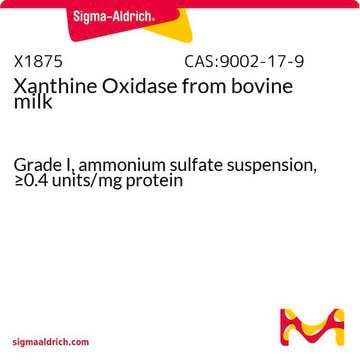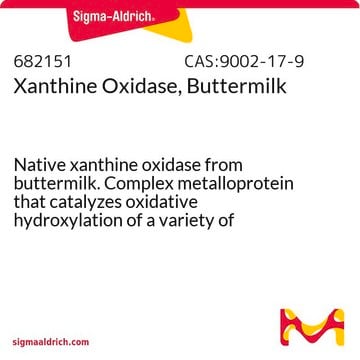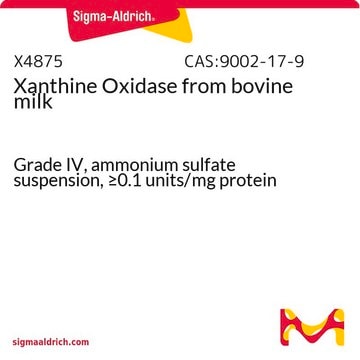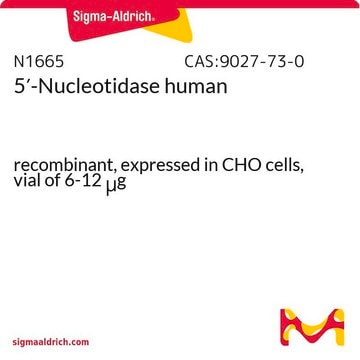For assay purposes, this product is prepared in 50 mM Potassium Phosphate Buffer, pH 7.5 at 25°C. The material is lyophilized from a solution containing BSA and sodium glutamate. While the solubility has not specifically been tested in sodium phosphate buffer, it is expected to be suitable. Please see the link below to review the assay protocol for this item:
https://www.sigmaaldrich.com/deepweb/assets/sigmaaldrich/product/documents/184/938/x2252enz.pdf
Kluczowe dokumenty
X2252
Xanthine Oxidase microbial
lyophilized powder, ≥7 units/mg solid
Synonim(y):
Schardingerenzyme, XO, hypoxanthine oxidase, XOD, Xanthine:oxygen oxidoreductase
Wybierz wielkość
634,00 zł
Wybierz wielkość
About This Item
634,00 zł
Polecane produkty
pochodzenie biologiczne
microbial
Poziom jakości
Formularz
lyophilized powder
aktywność właściwa
≥7 units/mg solid
masa cząsteczkowa
~160 kDa
metody
inhibition assay: suitable
kolor
brown
optymalne pH
7.5-8.0
Warunki transportu
wet ice
temp. przechowywania
−20°C
informacje o genach
Escherichia coli K12 ... xdhA(947116) , xdhB(947205) , xdhC(945148)
Szukasz podobnych produktów? Odwiedź Przewodnik dotyczący porównywania produktów
Opis ogólny
Xanthine Oxidase (XO), a versatile molybdoflavoprotein, is one of the forms of xanthine oxidoreductases (XORs). XO is characterized with two flavin molecules (FAD), two molybdenum atoms, and eight iron atoms bound per enzymatic unit.[1]
Zastosowanie
Działania biochem./fizjol.
Właściwości fizyczne
Optimum pH: 7.5 - 8.0
Optimum temperature: 65oC
pH Stability: pH 6.5 - 9.0 (25oC, 15hr)
Thermal stability: below 55oC (pH 8.0, 30min)
Definicja jednostki
Postać fizyczna
Przechowywanie i stabilność
persons
Inhibitor
Hasło ostrzegawcze
Danger
Zwroty wskazujące rodzaj zagrożenia
Zwroty wskazujące środki ostrożności
Klasyfikacja zagrożeń
Resp. Sens. 1
Kod klasy składowania
11 - Combustible Solids
Klasa zagrożenia wodnego (WGK)
WGK 3
Temperatura zapłonu (°F)
Not applicable
Temperatura zapłonu (°C)
Not applicable
Środki ochrony indywidualnej
Eyeshields, Gloves, type N95 (US)
Wybierz jedną z najnowszych wersji:
Certyfikaty analizy (CoA)
Nie widzisz odpowiedniej wersji?
Jeśli potrzebujesz konkretnej wersji, możesz wyszukać konkretny certyfikat według numeru partii lub serii.
Masz już ten produkt?
Dokumenty związane z niedawno zakupionymi produktami zostały zamieszczone w Bibliotece dokumentów.
Klienci oglądali również te produkty
Protokoły
The appearance of uric acid is measured at 293nm by spectrophotometry.
-
Guten Tag, in welchem Lösungsmittel und bis zu welcher Konzentration ist das Enzym gut löslich? Kann Natrium Phosphat Puffer verwendet werden? Danke.
1 answer-
Helpful?
-
Active Filters
Nasz zespół naukowców ma doświadczenie we wszystkich obszarach badań, w tym w naukach przyrodniczych, materiałoznawstwie, syntezie chemicznej, chromatografii, analityce i wielu innych dziedzinach.
Skontaktuj się z zespołem ds. pomocy technicznej










